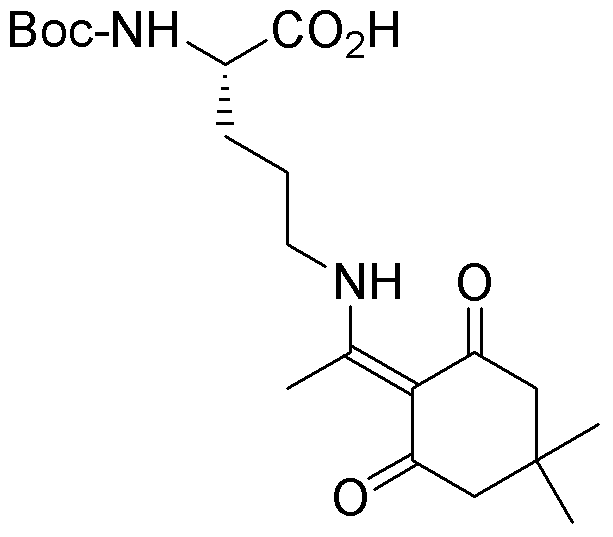Na-Boc-Nb-1-(4,4-dimethyl-2,6-dioxocyclohex-1-ylidene)ethyl-L-ornithine is widely utilized in research focused on:
- Peptide Synthesis: This compound serves as a key building block in the synthesis of peptides, which are vital in drug development and biological research.
- Drug Design: Its unique structure allows researchers to explore new therapeutic agents, particularly in the development of treatments for various diseases.
- Bioconjugation: It can be used in bioconjugation processes, facilitating the attachment of biomolecules to surfaces or other molecules, enhancing drug delivery systems.
- Research in Cancer Therapeutics: The compound's properties make it a candidate for studies aimed at developing targeted cancer therapies, potentially improving treatment efficacy.
- Analytical Chemistry: It is also applied in analytical methods to study complex biological systems, aiding in the understanding of metabolic pathways.
General Information
Properties
Safety and Regulations
Applications
Na-Boc-Nb-1-(4,4-dimethyl-2,6-dioxocyclohex-1-ylidene)ethyl-L-ornithine is widely utilized in research focused on:
- Peptide Synthesis: This compound serves as a key building block in the synthesis of peptides, which are vital in drug development and biological research.
- Drug Design: Its unique structure allows researchers to explore new therapeutic agents, particularly in the development of treatments for various diseases.
- Bioconjugation: It can be used in bioconjugation processes, facilitating the attachment of biomolecules to surfaces or other molecules, enhancing drug delivery systems.
- Research in Cancer Therapeutics: The compound's properties make it a candidate for studies aimed at developing targeted cancer therapies, potentially improving treatment efficacy.
- Analytical Chemistry: It is also applied in analytical methods to study complex biological systems, aiding in the understanding of metabolic pathways.
Documents
Safety Data Sheets (SDS)
The SDS provides comprehensive safety information on handling, storage, and disposal of the product.
Product Specification (PS)
The PS provides a comprehensive breakdown of the product’s properties, including chemical composition, physical state, purity, and storage requirements. It also details acceptable quality ranges and the product's intended applications.
Certificates of Analysis (COA)
Search for Certificates of Analysis (COA) by entering the products Lot Number. Lot and Batch Numbers can be found on a product’s label following the words ‘Lot’ or ‘Batch’.
*Catalog Number
*Lot Number
Certificates Of Origin (COO)
This COO confirms the country where the product was manufactured, and also details the materials and components used in it and whether it is derived from natural, synthetic, or other specific sources. This certificate may be required for customs, trade, and regulatory compliance.
*Catalog Number
*Lot Number
Safety Data Sheets (SDS)
The SDS provides comprehensive safety information on handling, storage, and disposal of the product.
DownloadProduct Specification (PS)
The PS provides a comprehensive breakdown of the product’s properties, including chemical composition, physical state, purity, and storage requirements. It also details acceptable quality ranges and the product's intended applications.
DownloadCertificates of Analysis (COA)
Search for Certificates of Analysis (COA) by entering the products Lot Number. Lot and Batch Numbers can be found on a product’s label following the words ‘Lot’ or ‘Batch’.
*Catalog Number
*Lot Number
Certificates Of Origin (COO)
This COO confirms the country where the product was manufactured, and also details the materials and components used in it and whether it is derived from natural, synthetic, or other specific sources. This certificate may be required for customs, trade, and regulatory compliance.


